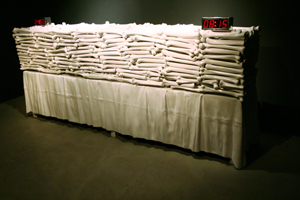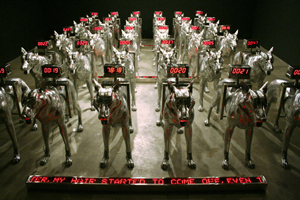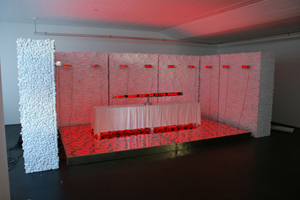|
|||||||||||||||||||||||||||||||||||||||||||||||||||||||||||||||||||||||||||||
|
|
|||||||||||||||||||||||||||||||||||||||||||||||||||||||||||||||||||||||||||||
|
The visible and beyond
As is his wont, T. V. Santhosh through his paintings manages to play a dual game; visually he presents an imagery withdrawn from specificities of time and space (rather place) reducing it to a simple structure of common references, and with it attempts to stimulate some specific latent emotions within his viewers. T. V. Santhosh while speaking to Vrushali Dhage, traces the roots to his recent sculptural works.
VD: You have been trained as a sculptor and have been practicing painting too; with these works do you intend to get back to your sculptural practice? TVS: No, I certainly don’t intend to make any strict shift like that. You can say that these works are an extension of my drawings in a three dimensional space. I am still drawing from the same references, predominantly mediatic images, as I do for my paintings. It is just that I had lot of ideas in my mind, which I thought would find a better expression as sculptures than paintings. VD: Why mediatic images?
TVS:
To an extent our
understanding of events, be it current or historical, is based on the
‘truth’ presented by the media. And there are many versions of this
truth, which in turn questions the authenticity of these accounts, as
there is some concealed truth. In my works I do not intend to mirror
any political undercurrents but to surface parallel realities
surpassing the local specificities. For instance the very word ‘terror
or terrorism’ is no longer alien to us. We no longer need to make an
extra effort to empathize or take cognizance of such unruly activities
faced by, say, individuals from different countries, we are no longer
hit by a level of shock, as now we are living constantly and
simultaneously in worlds which are afflicted by these common issues. TVS: I believe that there are two notions of art, one of healing or curing and the other resistance-oriented; in my works healing dominates. There is a need to look at social aspects from these points of views. VD: Can you tell us about how your approach got moulded… TVS: For that I will have to trace back to the time when I was part of a group called Pratikarna Sangh, in Kerala. It was not a structured NGO but was similar to one. Later the group was to form its manifesto. The Sangh was an eclectic organization, it had people who supported the Leftist, Gandhian, anti-Imperialist, and Marxists views, and as a result the ideology which it followed was an anti-consumerist one. VD: What sort of activities did the group undertake?
TVS:
The group was
involved with various social activities – ecological, feminist etc. It
was during this period, i.e. in the 80's that the Bhopal Gas tragedy
and the Chernobyl disaster occurred. Both these events questioned the
notion of technological progress; whether the direction of progress
was towards exploitation and finally tragedy. These tragedies were
looked upon as side effects of modernism therefore the group strongly
resisted it. There were also other problems like that of global warming and
lowering of the fertility level of soil due to excessive use of
fertilizers and pesticides. 'One Straw Revolution' a book that
spoke on sustainable, natural farming based on harmless traditional
methods by Masanobu Fukuoka, a Japanese agricultural activist too made
a mark in my mind. And then the need of the hour was to create mass
awareness about these issues. TVS: No, the way of communicating was not through paintings but posters. Then people were not interested in pure aesthetics. Art was supposedly non-constructive, and we had to bridge the gap between the common people and art. I helped the group to make posters, which travelled all over Kerala, and yes, even performances. We also thought that posters or paintings would not be as far reaching as drama and literature, which had a strong presence in Kerala. We thought that no one would come to see, but the public response was surprisingly large. VD: Did these happenings have a direct impact on you? TVS: Well they did have a direct impact, as they certainly instigated a thought process. To me the victims of Bhopal Gas Tragedy and the Chernobyl, stood as individual examples of the hazards of the technological progress proving that errors could happen, and the side effects of which were too huge to be borne. Similar was the feeling with respect to the Hiroshima, Nagasaki nuclear explosions. The 'mushroom cloud' was a threatening image standing against humanity. None of us witnessed the explosion but could still empathize. What intrigued me was that these feelings and reactions were no longer restricted to the residents of the two fateful cities but were universal, the feeling of 'fear' and threat of a reoccurrence, at an equal amplitude, ran across and gripped the minds of people universally. VD: Can we say that period played an instrumental role in moulding your political understanding too? TVS: Certainly. VD: After Kerala, things must have not been too different at Santiniketan isn't it…? TVS: Yes, Santiniketan too was strongly rooted in traditions and resisted modernist practices. There was no desire to follow any 'isms'. VD: What about Baroda? TVS: Baroda had an eclectic language. Backed by lot of ideas, beliefs and notions which had influenced me and which were formed while I was in Kerala and Santiniketan, I experimented a lot in Baroda. I started working on the root-cause theory. And later worked on the 'wound theory' which dominated my work. VD: Please tell us a bit about it… TVS: For instance if one sees people ravaged by wars or deeply wounded people, our instantaneous reaction would be that of repulsion; but a photographic image or a painting of it might not evoke the same reaction or hit on the same sensory note. The effect is mitigated by a huge margin. To take it further, one might be drawn towards such images in order to explore the detailing of it. VD: In your paintings, with the positive/negative treatment of the pictures you surpass local specificities, how have you transferred it in your sculptures? TVS: As I mentioned, I am still drawing from mediatic images and historical accounts for both my paintings and sculptures. For instance an image of a barbed wire (esp. on national borders), or that of an explosion no longer have a localized reference. In one of my work Houndingdown I have tried to show the same. In Germany, during the World War II, dogs attached with timed explosives were employed as suicide bombers; in the current scenario, in the face of terror, dogs (sniffer dogs) are used to trace landmines and timed devices. The timers on these are synonymous of the time left with us – we are counting our days. This pack of thirty dogs seems menacing at the first sight, but the same dogs share a diametrically opposite role of protectors too. In this work I also added a text – a narration of a girl who survived the Hiroshima explosion. VD: Why did you choose this particular narration? TVS: The narration of the fourteen year old survivor (girl) of the Hiroshima explosion stood symbolic – words – describing violence, which could / can be suffered by any one. The girl was mistakenly thrown into a pile of dead bodies. It was only when she moved that people knew that she was still alive. She expresses a feeling of awe as she saw the mushroom cloud; certainly enigmatic and powerful, and yet a terrible image after the mass destruction. In her description, she mentions a river, which no longer looked the same, as now it was filled with corpses. The description seems surrealistic but unfortunately is a real testament. VD: In your work titled, A Room to Pray… you have created a space to pray with a pile of bones… the thought is very intimidating. TVS: It is not unusual. There are many churches in Rome and the Czech Republic, which are decorated with bones. If you look at a war torn land, to me, these bones signify the errors in history. The table is symbolical of The Last Supper, of the prophecies of the future, of the death of humanity. The room is an evidence of the gruesome happenings and experiences. It does not point or signify an individual event but is symbolical of acts against humanity; and yet it is in this room that one prays for humanity. VD: Your works somehow seem to draw its viewers to react... TVS: If we pan across the happenings over the times, terror has had a pervasive presence. Earlier these sort of happenings would run a strong wave of shock, but its repetition has somewhat numbed our reactions. And yet the fear still persists. The need is simply to raise questions; and then what remains is for a sensate individual to relate and think. |
|||||||||||||||||||||||||||||||||||||||||||||||||||||||||||||||||||||||||||||
|
Fourteen year old survivor (girl) of the Hiroshima explosion : |
|||||||||||||||||||||||||||||||||||||||||||||||||||||||||||||||||||||||||||||
 thus, he disclosed the secret of destiny - II, 2007 |
 Howndingdown, 2007 |
||||||||||||||||||||||||||||||||||||||||||||||||||||||||||||||||||||||||||||
|
© The Guild. All rights reserved. |
|||||||||||||||||||||||||||||||||||||||||||||||||||||||||||||||||||||||||||||
